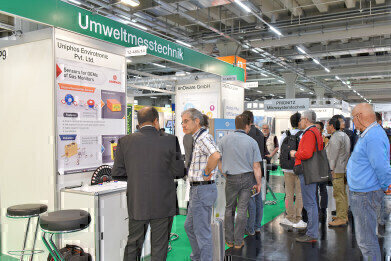Air sensors
SENSOR+TEST 2016: Sensors for VOC, Toxic, Flammable and Explosive Gases on Offer
Mar 01 2016
The 23rd international measurement fair, the SENSOR+TEST, will be held from the 10th to the 12th of May, 2016, on the fair grounds of the Nürnberg Exhibition Center. This is the communication platform across all branches of industry for developers, design engineers, and users in the area of sensor, measuring, and testing technology. It is also a must for students of natural sciences and engineering. State-of-the-art sensors and measurement technology are crucial for future advances in technical devices, machines, systems, and processes. And without the latest testing equipment, the continuously increasing requirements for reliability of products and processes cannot be met.
There is no comparable platform in all of Europe, where users can meet so many innovative suppliers of sensor, measuring, and testing technology from all over the globe. The AMA Association for Sensors and Measurement, the major supporter, and the AMA Service, the organiser, are counting this year on approximately 580 exhibitors and about 8,000 visitors.
Sensors for determining the concentration of combustible, explosive, toxic, or other gases, have been at the focus of the SENSOR+TEST for years. In the reports submitted by the exhibitors this year, optical processes are again emphasised. Alongside catalytic sensors, there is a wide offering of wet chemical sensors for pH value, oxygen concentration, or conductivity.
Nondispersive infrared gas sensors are often used to detect CO2 in the air because of their small size. They have built-in temperature compensation, digital outputs, and analogue voltage outputs. They are used to monitor room air, industrial processes, for safety and security monitoring and in agriculture and stock breeding.
MEMS sensors measure carbon-dioxide and methane based on changes in their conductivity by chemsorption or calometrical measurements of gas molecules at a sensitive layer. An integrated polysilicon heating element generated the required temperatures. Various polymer films increase the sensitivity of small gas concentrations in the ppm range. Electrochemical toxic gas sensors are being shown by a Japanese supplier. They have a high sensitivity and selectivity for carbon-monoxide, hydrogen-sulfide, nitrogen-oxide, chlorine, sulphur-dioxide, and ammonia. A CO2 sensor uses two detector elements for absolute measurements. Each sensor module is calibrated individually and supplied with a UART and an I2C digital interface. Areas of application include hospitals, ventilation control in buildings and individual rooms. A microprocessor supported sensor analyses combustible and toxic gases in Ex zones 1 and 2. A batter-operated electrochemical sensor uses an electrolyte instead of a water reservoir, making it ultra-compact and ideal as a portable or room CO detector or as a multisensor fire detector.
Based on NDIR and NDUV absorption-photometry, a novel gas measuring system was developed for industrial applications. The device was especially designed for rapid display of the measured values in a period of time from t90 between 100 ms and 1 s. Micromechanical surface-emitting diodes (IR range) and LEDs (UV range) that can be operated with high modulation frequencies are used. The spectral range extends from 250 nm to 12 µm.
Oxygen sensors are continuously gaining in significance in many sophisticated production processes. For instance, in 3D pressure applications in which metals, alloys, or ceramics must be bonded in layers, the ambient oxygen concentration must be precisely controlled. Other important applications in which these kinds of sensors play a central role are fire protection equipment, cell incubators, products for food conservation, and for fruit and vegetable ripening as well as for gas analysis instruments. New, custom-tailored zirconium-oxide oxygen sensors cover the entire range of all possible oxygen concentrations from a small number of ppm to 95%. They can also be used as humidity sensor. Thus, they are used, for instance, in industrial ovens for moisture regulation at high temperatures (>100 °C). These oxygen sensors operate at temperatures of up to 300 °C. An important influencing factor of bad air quality is the low boiling point of volatile organic compounds (VOC). Air quality modules can now detect with chemical MEMS metal-oxide semiconductors such VOCs. They are used as modules in air conditioning systems in vehicles, intelligent controls of HVAC systems, and in bathroom and kitchen ventilation control.
With about 580 exhibitors, the SENSOR+TEST 2016 is the measuring fair in Europe – with exhibitors from all over the world. Two conferences will be held parallel to the trade fair from 10 to 12 May 2016: the 18th GMA / ITG “Sensors and Measuring Systems 2016” und die 36th etc2016 - European Telemetry and Test Conference as well as two expert forums with presentations in Halls 1 and 5 – the “Innovative Testing” forum on 11 May in Hall 1 and the special topic “Measurement in the Cloud” on 10 May in Hall 5. And further special topics are to be found at the theme stand “Vision Sensors and Systems” and a community stand supported by the BMWi for young, innovative enterprises – a rich and varied offer from the Measurement Fair SENSOR+TEST 2016.
Digital Edition
IET 35.2 March
April 2025
Air Monitoring - Probe Sampling in Hazardous Areas Under Extreme Conditions - New, Game-Changing Sensor for Methane Emissions - Blue Sky Thinking: a 50-year Retrospective on Technological Prog...
View all digital editions
Events
Apr 30 2025 Ankara, Turkey
May 06 2025 Nuremberg, Germany
May 10 2025 Karachi, Pakistan
May 11 2025 Vienna, Austria
May 11 2025 Seoul, South Korea




-13.jpg)


_(4427399123)-(2).jpg)

.jpg)









